X
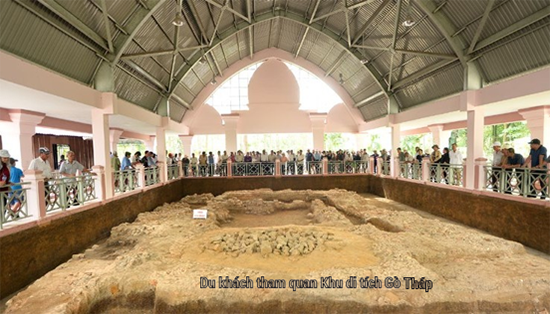
Go Thap relic belongs to hamlet 1, Tan Kieu commune, Thap Muoi district, Dong Thap province, about 11 km north of My An town, Thap Muoi district, 43 km northeast of Cao Lanh city, with a total area area of about 300ha. Go Thap relic was classified as a National Monument in 1989 by the Ministry of Culture and Information and was classified as a special national monument of archaeological and artistic architecture by the Prime Minister in 2012. Go Thap relic is considered as a convergence of special values of culture, history, spiritual beliefs and tourism that is hard to get anywhere.
Culturally: Go Thap used to be a small nation of Funan Kingdom which existed from the 2nd century BC to the 12th century AD; Oc Eo culture with many types of archaeological relics such as residence relics, architectural relics, vestiges of god ponds, god wells, god temples (shiva temple, vishnu god and surya sun god) ... and there are a large number of valuable archaeological artifacts such as the collection of Hindu statues (there are 2 vishnu statues recognized as national treasures), wooden Buddha statues, a collection of more than 400 gold artifacts , ... was recognized by the Vietnam Record as the "The largest collection of Oc Eo - Go Thap gold artifacts in Vietnam" in 2014.
In terms of history: Go Thap has dazzling histories, recording the glorious feats of the two national heroes Thien Vo Vo Duong and Nguyen Binh Kieu in the war against the French colonialists. Go Thap is the "capital of resistance" of the whole southern region, the "people's heart" base of the Party Committee and the Administrative Resistance Committee of the South in the period 1946-1949. Go Thap is also a place to mark the victory. resounding of the 502th Battalion - the elite children of his homeland of Dong Thap, in the collapse of the "Thap Muoi Ten" built by the Ngo Dinh Diem government in early 1960.
In terms of spirituality and beliefs: Go Thap relic also stands out through spiritual values of beliefs with many religious-belief relics such as Thien Ho Duong temple, Doc Binh Kieu temple, Thap Linh pagoda, Mieu temple. Ba Chua Xu, Hoang Co Temple. Every year, there are two major festivals, namely, the Goddess of Mercy Festival (full moon in the third lunar month) and the death anniversary of the heroes Thien Ho Duong and Doc Binh Kieu (full moon in the 11th lunar month). Each festival lasts for three days, attracting hundreds of thousands of visitors to visit and worship.
Regarding tourism: This is considered as the "navel" of the whole region of Dong Thap Muoi because of its natural ecological environment, wild animals and plants with typical characteristics of the region with many specialties with strong flavors. countryside like grilled snakehead fish, field mice; Dried lotus leaf salad, fish sauce with dried fish, anabas, etc. With the great values of culture, history, spiritual beliefs and tourism, Go Thap relic has become an attractive meeting place. , the destination not to be missed by every traveler on the journey to discover the Dong Thap Lotus land.
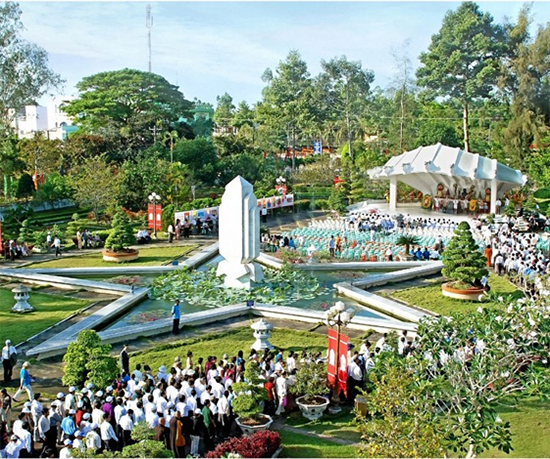
Nguyen Sinh Sac relic area
The site of Nguyen Sinh Sac's grave complex was built on August 22, 1975 and inaugurated on February 13, 1977. This is a tribute to the dedication of Mr. Nguyen Sinh Sac, a patriotic scholar, a businessman, a man who had merit of giving birth and education to President Ho Chi Minh. On the occasion of the 100th birthday of President Ho Chi Minh (May 19, 1990), Nguyen Sinh Sac relic built another model of Uncle Ho's stilt house with a ratio of 1: 1 and lotus pond. In addition, the relic also displays two works of art carved in the form of copper drums and nine dragon heads, lotus and 12 Chinese zodiac carvings from oil wood that have been recorded in the Vietnamese record book of raw wood. Vietnam's largest carving block in 2014.
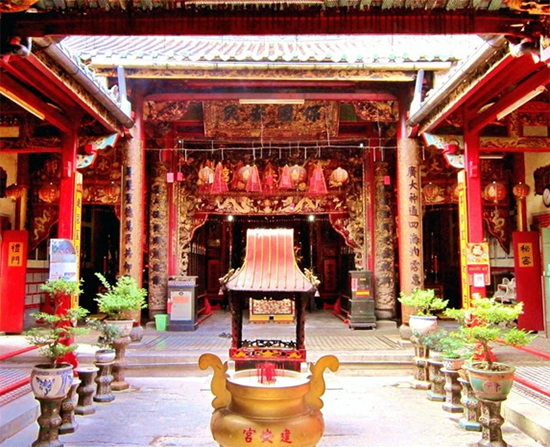
Kien An Cung Pagoda
Kien An Cung Pagoda, also known as Ong Quach Pagoda, is located in Ward 2, downtown Sa Dec, Dong Thap Province. This is a cultural work with a unique and solemn architecture that has been recognized by the Ministry of Culture and Information (now the Ministry of Culture, Sports and Tourism) as a National-level Cultural-Historical Monument of the year. 1990. This is an ingenious and well-designed architectural work with sophisticated carvings, not only adding beauty but also educating and advising people to do good deeds. The two sides of the wall adorned the ceiling and the cross and many old stories have profound meanings. On the main surface of the temple wall is decorated with trees, birds, animals, human statues made of miniature colored ceramic pieces forming pictures lying on the edge of glass. The front roof of the door has 4 wooden flower pots painted with gold-plated lacquer, in the middle is a diaphragm "Kien An Cung". On the door, there are 6 gilded unicorns, on each side of the door, there are scenes of the life of the king and the mandarins. On the two sides of the main door there are two couplets decorated around the pattern, background touching apricot blossom and golden gilded cranes. The main door has paintings in the style of waterways, with delicate and sharp strokes, while the two sides have carvings of lotus, vivid birds ... Every year the temple has 2 sacrifice days: February 22 and February. 8/22 lunar calendar. Every 3 years, the pagoda will set up a mankind, worship to pray for the passing of the deceased and pray for the peace and happiness of the people. while the two sides have carvings of lotus flowers, vivid birds ... Every year the temple has 2 sacrifice days: February 22 and August 22 of the lunar calendar. Every 3 years, the pagoda will set up a mankind, worship to pray for the passing of the deceased and pray for the peace and happiness of the people. while the two sides have carvings of lotus flowers, vivid birds ... Every year the temple has 2 sacrifice days: February 22 and August 22 of the lunar calendar. Every 3 years, the pagoda will set up a mankind, worship to pray for the passing of the deceased and pray for the peace and happiness of the people.
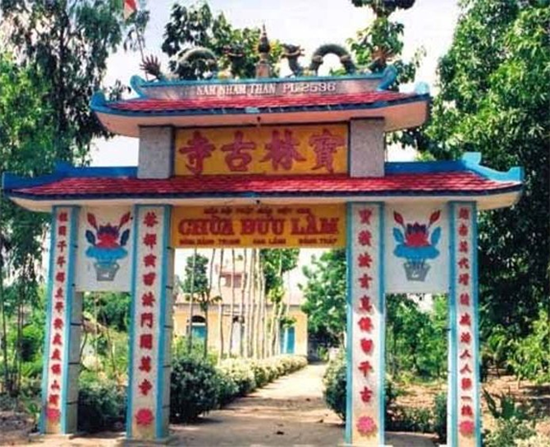
Buu Lam Tu
Buu Lam Pagoda is also known as To Cai Beo Pagoda (located in Hamlet 3, Binh Hang Trung Commune, Cao Lanh District, Dong Thap Province), the first temple in Dong Thap Muoi area, also one of the temples. First temple in the South. Born around the end of the 17th century, Buu Lam pagoda once had hundreds of Buddha statues (including dozens made of rattan trees), many stalagmite, elaborate carved carvings, bells, seals, ancient copper censer , ... Up to now, the pagoda has experienced 12 generations of abbot; trained generations of monks, many of whom have been propagating, opening paint, and presided over many pagodas throughout the Mekong Delta.
Inheriting and promoting the patriotic tradition of Vietnamese Buddhism, during the anti-French period, Buu Lam pagoda has become a communication, food and logistical support station ... for the insurgents. During the anti-American war to save the country, the temple continued its logistics mission and was a breeding ground for revolutionary soldiers. The precinct of the pagoda tower is a secret tunnel that hides officials and the old tree-trunk is also a place where some officials hide and hide from enemy raids. During the two resistance wars, the monks, nuns, Buddhists of the temple were devoted to the religion and the nation, contributing to the cause of national liberation in the locality.

Xeo Quyt - Historical area - ecology of Melaleuca forest
Xeo Quyt relic is located in My Hiep commune and My Long commune, Cao Lanh district, 30km from Cao Lanh city. In the past, there were wild grasses, wild canals and ditches. From 1960 to 1975, Kien Phong Provincial Party Committee (now Dong Thap) was chosen as a strategic base to lead the resistance people. Xeo Quit relic area of about 50ha is the typical anti-American resistance base of the flooded plain covered by primeval Melaleuca forests of 20ha wide with tangerine vines called Melaleuca trees like paintings. Thuy charming. This place also preserves relics such as fighting fortifications, bomb shelters, secret vaults, etc., which are attractions for domestic and foreign tourists.
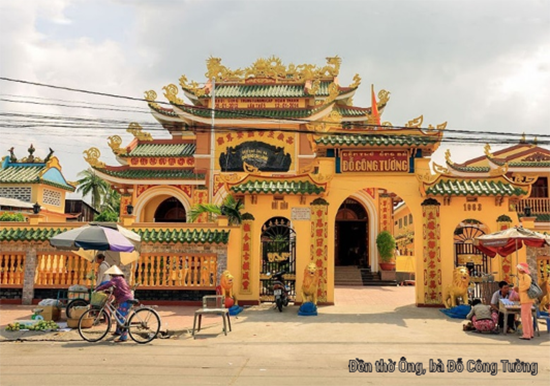
The temple to worship Mr. and Mrs. Do Cong Tuong
It is said that Mr. Do Cong Tuong was a great person of great merit to the same land of Cao Lanh. When he / she died, people in the area built the temple to express their gratitude. Since its construction (1820), undergoing numerous renovations and restoration, this ancient simple temple has now been an ancient and solemn building located on Le Loi Street, Ward 2, Cao Lanh City. . On April 20, 2001, the temple was designated a Provincial Monument. Since 2009, under the decision of the People's Committee of Cao Lanh city, the annual death anniversary of Mr. and Mrs. Do Cong Tuong has officially become a cultural-historical festival of the city, with many fun activities such as: : music, amateur music, lion dance, nourishing gymnastics, football competitions, cross-country running and folk games ...
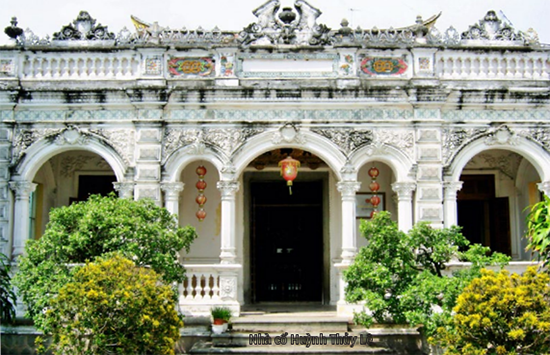
The ancient house of Huynh Thuy Le
Huynh Thuy Le Old House is located at 225A Nguyen Hue Street, Ward 2, Sa Dec City, Dong Thap Province, built by Mr. Huynh Cam Thuan in 1895 and restored in 1917. The house has a special architecture and is furnished. royal unique. The house was originally the residence of Mr. Huynh Thuy Le's family - the first love of the French female writer, Marguerite Duras. This love later became a memoir for her to write the famous novel "The Lover" in 1984. This work was adapted into the film by the French director Jean-Jacques Annaud in 1992. The old house of Huynh Thuy Le was the harmonious combination between Eastern and Western architecture. The entire house is built on an area of 258m2 shaped like a traditional Vietnamese house, with a yin-yang tile roof, the two gables are curved like a temple in the style of the Northern pagoda temple in order to create soft features for the roof. However, The architecture inside the building is high and cool, the wall is built of very thick bricks from 30cm - 40cm, surrounded by wooden frame structure, which increases the bearing capacity in the traditional French architecture. The house has three rooms, decorated in the Chinese style. The frames on both sides carved the flowers and birds expressing the wealth of the family. Especially, in the middle of the main house is worshiping Quan Cong, a traditional Chinese belief; At the same time, it also shows strength and prosperity in life. The wooden doors, cabinets, beds, altars are carved elaborately and exquisitely. In 2008, the ancient house was certified as a provincial monument and recognized as a National monument in 2009. The house has three rooms, decorated in the Chinese style. The frames on both sides carved the flowers and birds expressing the wealth of the family. Especially, in the middle of the main house is worshiping Quan Cong, a traditional Chinese belief; At the same time, it also shows strength and prosperity in life. The wooden doors, cabinets, beds, altars are carved elaborately and exquisitely. In 2008, the ancient house was certified as a provincial monument and recognized as a National monument in 2009. The house has three rooms, decorated in the Chinese style. The frames on both sides carved the flowers and birds expressing the wealth of the family. Especially, in the middle of the main house is worshiping Quan Cong, a traditional Chinese belief; At the same time, it also shows strength and prosperity in life. The wooden doors, cabinets, beds, altars are carved elaborately and exquisitely. In 2008, the ancient house was certified as a provincial monument and recognized as a National monument in 2009. altars are carved elaborately, exquisitely. In 2008, the ancient house was certified as a provincial monument and recognized as a National monument in 2009. altars are carved elaborately, exquisitely. In 2008, the ancient house was certified as a provincial monument and recognized as a National monument in 2009.